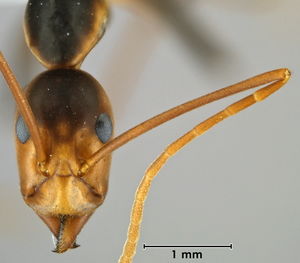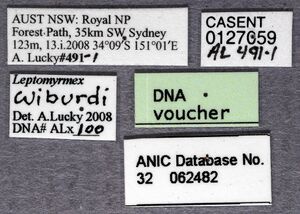Leptomyrmex wiburdi
| Leptomyrmex wiburdi | |
|---|---|

| |
| Leptomyrmex wiburdi | |
| Scientific classification | |
| Kingdom: | Animalia |
| Phylum: | Arthropoda |
| Class: | Insecta |
| Order: | Hymenoptera |
| Family: | Formicidae |
| Subfamily: | Dolichoderinae |
| Tribe: | Leptomyrmecini |
| Genus: | Leptomyrmex |
| Species: | L. wiburdi |
| Binomial name | |
| Leptomyrmex wiburdi Wheeler, W.M., 1915 | |
| Synonyms | |
| |
L. wiburdi has been recorded in rainforest, wet sclerophyll and dry sclerophyll. Nests occur in soil, in standing or fallen trees or snags, in stumps, and under rocks.
| At a Glance | • Replete Workers |
Identification
This species can be distinguished by its broad head, which is widest posterior of the eyes, short scapes and generally small size. L. wiburdi can be easily mistaken for Leptomyrmex cnemidatus or Leptomyrmex erythrocephalus, as the general body shape and round postocular portion of the head are similar amongst these three species which co-occur in New South Wales. There is no ‘typical’ color pattern that characterizes L. wiburdi workers, rather they take on a variety of color patterns, including the typical patterns seen in L. cnemidatus and L. erythrocephalus; workers with different color forms have even been observed in a single nest. Many individuals possess mottled brown-black coloration on the head and mesosoma, which is not seen in either L. cnemidatus or L. erythrocephalus. L. wiburdi workers evidently mimic workers of co-occurring species of Leptomyrmex. (Lucky and Ward 2010)
Identification Keys including this Taxon
Distribution
Latitudinal Distribution Pattern
Latitudinal Range: -17.76666667° to -35.66972351°.
| North Temperate |
North Subtropical |
Tropical | South Subtropical |
South Temperate |
- Source: AntMaps
Distribution based on Regional Taxon Lists
Australasian Region: Australia (type locality).
Distribution based on AntMaps
Distribution based on AntWeb specimens
Check data from AntWeb
Countries Occupied
| Number of countries occupied by this species based on AntWiki Regional Taxon Lists. In general, fewer countries occupied indicates a narrower range, while more countries indicates a more widespread species. |

|
Estimated Abundance
| Relative abundance based on number of AntMaps records per species (this species within the purple bar). Fewer records (to the left) indicates a less abundant/encountered species while more records (to the right) indicates more abundant/encountered species. |

|
Biology
Castes
Worker
Images from AntWeb
    
| |
| Worker. Specimen code casent0127038. Photographer Andrea Lucky, uploaded by California Academy of Sciences. | Owned by PSWC, Philip S. Ward Collection. |
Colour variation in L. wiburdi.
           
| |
| . | |
Phylogeny
| Leptomyrmex |
| ||||||||||||||||||||||||||||||||||||||||||||||||||||||||||||||||||||||||||||||||||||||||||||||||||||||||||||||||||||||||||||||||||||||||||
Based on Barden et al., 2017. Note only selected Leptomyrmex species are included.
Nomenclature
The following information is derived from Barry Bolton's Online Catalogue of the Ants of the World.
- pictus. Leptomyrmex wiburdi var. pictus Wheeler, W.M. 1915d: 273 (w.) AUSTRALIA. Wheeler, G.C. & Wheeler, J. 1966: 728 (l.). Subspecies of wiburdi: Wheeler, W.M. 1934c: 101. Junior synonym of wiburdi: Lucky & Ward, 2010: 60.
- wiburdi. Leptomyrmex wiburdi Wheeler, W.M. 1915d: 272, fig. 7 (w.) AUSTRALIA. Wheeler, W.M. 1934c: 99 (m.); ; Lucky & Ward, 2010: 61 (ergatoid q.). Senior synonym of pictus: Lucky & Ward, 2010: 60.
Type Material
- Syntype, 1 worker, Jenolan Caves, New South Wales, Australia, Los Angeles County Museum of Natural History.
- Syntype, 4 workers, Bulli Pass, New South Wales, Australia, Museum of Comparative Zoology.
- Syntype, 14 workers, Jenolan Caves, New South Wales, Australia, Museum of Comparative Zoology.
- Syntype, 1 worker, Katoomba, New South Wales, Australia, Museum of Comparative Zoology.
- Syntype, 2 workers, Jenolan Caves, New South Wales, Australia, Museum Victoria, Melbourne.
- Syntype, 3 workers, Jenolan Caves, New South Wales, Australia, National Museum of Natural History.
Unless otherwise noted the text for the remainder of this section is reported from the publication that includes the original description.
Description
Worker
Lucky and Ward (2010) - measurements (n = 12)HL 1.65–1.94, HW 1.15–1.33, MFC 0.27–0.36, IOD 0.70–0.86, SL 2.74–3.3, EL 0.36–0.45, WL 3.06–3.65, PW 0.94–1.15, DPW 0.30–0.43, HTL 3.32–3.88, HTWmin 0.13–0.17, HTWmax 0.22–0.26, CI 0.66–0.70, SI 2.29–2.64, OI 0.09–0.12, HTC 0.56–0.69.
Relatively small species (HL 1.65–1.94; HW 1.15–1.33) with broad head (CI 0.66–0.70), excluding mandibles head width more than 3/5 of length. Head widest posterior to eyes, sides of head straight, narrowing anteriorly, genae slightly concave. Beyond eyes head broadly and distinctly rounding into posterior margin. Masticatory margin of mandible with approximately 20 teeth and denticles interspersed. Anterior clypeal margin medially concave. Eyes positioned posteriorly to midline of head, relatively large, hairless, not surpassing margins of head. Antennal scapes relatively short, not compressed, surpassing posterior margin of the head by less than 2/3 their length.
Pronotum stout, very convex. Dorsal face of propodeum more than twice as long as declivity, angle joining the two very broadly rounded. Propodeum with distinct transverse impression at anterior end. Petiole triangular in profile, dorsum with medial longitudinal impression, anterior face not much longer than posterior face, ventral suface of petiole distinctly projecting. Gaster ellipticaL. Legs relatively short, tibiae distinctly compressed.
Surface subopaque, very finely and densely shagreened. Mandibles slightly shining, coarsely punctate along apical border. Pubescence extremely fine, giving the body a pruinose appearance. Hairs few, confined to clypeus, mandibles and venter.
Coloration extremely variable; ranging from erythrocephalus-like to rufipes-like coloration, with many intermediate states apparently co-occurring. A common color pattern presents a rufotestaceous head obfuscated toward the postocular margin, mottled dark brown to black mesosoma and legs with joints and sutures pale, black gaster, and mandibles, antennae and tarsi rufotestaceous.
Queen
Lucky and Ward (2010) – Head broader than in worker. Three ocelli deeply set into head in triangular formation, the anteriormost one largest, the posterior two smaller. Pronotum, mesonotum and propodeum voluminous, convex. The anterior portion of the mesonotum with a slight medial bump. Dorsal face of propodeum raised, convex. Petiole broader than high. Gaster globose, larger than in worker. Scapes, femora and tibiae broad, robust. Surface of body appearing dusty, shagreened.
Male
Lucky and Ward (2010) – measurements (n = 4) HL 1.39–1.48, HW 1.09–1.15, SL 0.48–0.54, EL 0.54–0.61, HTL 3.14–3.42, CI 0.76–0.81, SI 0.42–0.49, SI2 1.10–1.33.
Wheeler (1934) - Head, including the mandibles, twice as long as broad, the postocular portion subtrapezoidal, with straight posterior and lateral borders and rounded posterior corners. Eyes very convex, subreniform, with sinuate internal orbits, only about twice as long as the concave, subparallel cheeks and therefore intermediate in size between the eyes of L. erythrocephalus cnemidatus and L. nigriventris. Ocelli also intermediate. Mandibles short and thick, with obtuse tips, their masticatory border short and not distinctly denticulate, scarcely longer than the basal border with which it forms a rounded obtuse angle. Antennal scapes nearly four times as long as broad; first funicular joint slightly longer than broad, second joint twice as long; joints 3-6 much longer, bent near their base. Thorax shaped as in the species previously described, but the base of the epinotum in profile straight and only twice as long as the straight sloping declivity and forming a distinct obtuse angle with it. Petiole very slightly longer than broad; its node much lower and less differentiated than in the worker; in profile somewhat higher and feebly angular in the middle; ventral surface only slightly convex anteriorly. Gaster clavate, narrow at the base, enlarged at the tip. Genitalia large, extruded; stipites oval, or rounded-triangular, longer than broad, punctate, densely and finely pilose; volsellae rather broad, boot-shaped. Legs short; tibiae terete, median pair bowed, hind pair feebly flexuous. Wings rather small (7 mm.) pterostigmal appendage pedunculate, sausage-shaped; basal two-fifths of cubitus absent.
Subopaque; gaster more shining, rather finely and sharply shagreened.
Hairs almost absent, except on the stipites and cerci; very few on the mandibles. Pubescence yellowish, very fine, appressed, most distinct on the gaster, head, epinotum and mesopleurae.
Pale brownish yellow; gaster dark brown, except the base of its first segment, which is yellow, and the genital squamulae, which are rich castaneous brown, very smooth and shining. Pleurae, epinotum and dorsal surface of petiole clouded with fuscous. Wings yellow, with pale yellow veins.
References
- Lucky, A. 2011. Molecular phylogeny and biogeography of the spider ants, genus Leptomyrmex Mayr (Hymenoptera: Formicidae). Molecular Phylogenetics and Evolution 59: 281-292. doi:10.1016/j.ympev.2011.03.004
- Lucky, A. & Ward, P.S. 2010. Taxonomic revision of the ant genus Leptomyrmex Mayr. Zootaxa 2688: 1-67. PDF
- Wheeler, W. M. 1915e. The Australian honey-ants of the genus Leptomyrmex Mayr. Proc. Am. Acad. Arts Sci. 51: 255-286 (page 272, fig. 7 worker described)
- Wheeler, W. M. 1934c. A second revision of the ants of the genus Leptomyrmex Mayr. Bulletin of the Museum of Comparative Zoology 77: 69-118 (page 99, male described)
References based on Global Ant Biodiversity Informatics
- Lucky A., and P. S. Ward. 2010. Taxonomic revision of the ant genus Leptomyrmex Mayr (Hymenoptera: Formicidae). Zootaxa 2688: 1-67.
- Taylor R. W. 1987. A checklist of the ants of Australia, New Caledonia and New Zealand (Hymenoptera: Formicidae). CSIRO (Commonwealth Scientific and Industrial Research Organization) Division of Entomology Report 41: 1-92.
- Wheeler W. M. 1915. The Australian honey-ants of the genus Leptomyrmex Mayr. Proceedings of the American Academy of Arts and Sciences 51: 255-286.
- Wheeler W. M. 1934. A second revision of the ants of the genus Leptomyrmex Mayr. Bulletin of the Museum of Comparative Zoology 77: 69-118.

